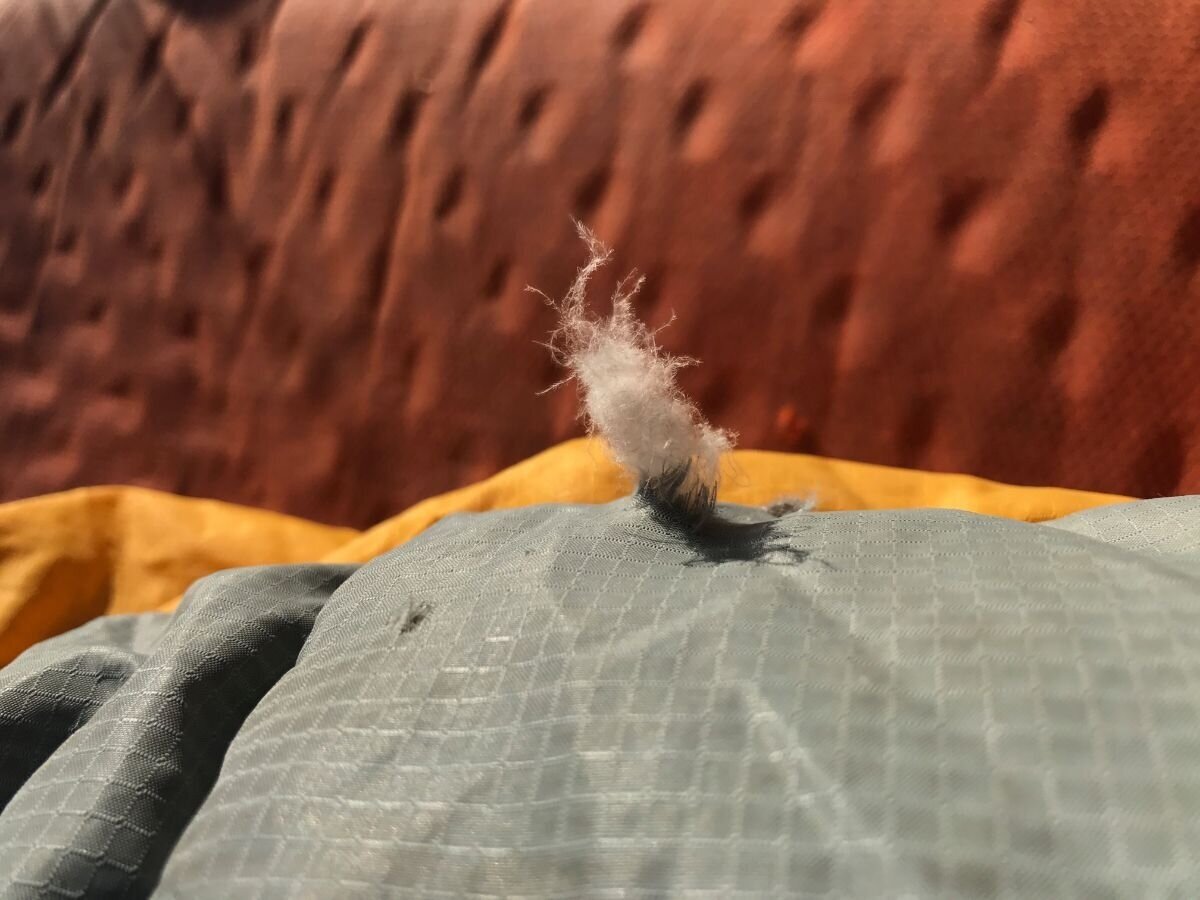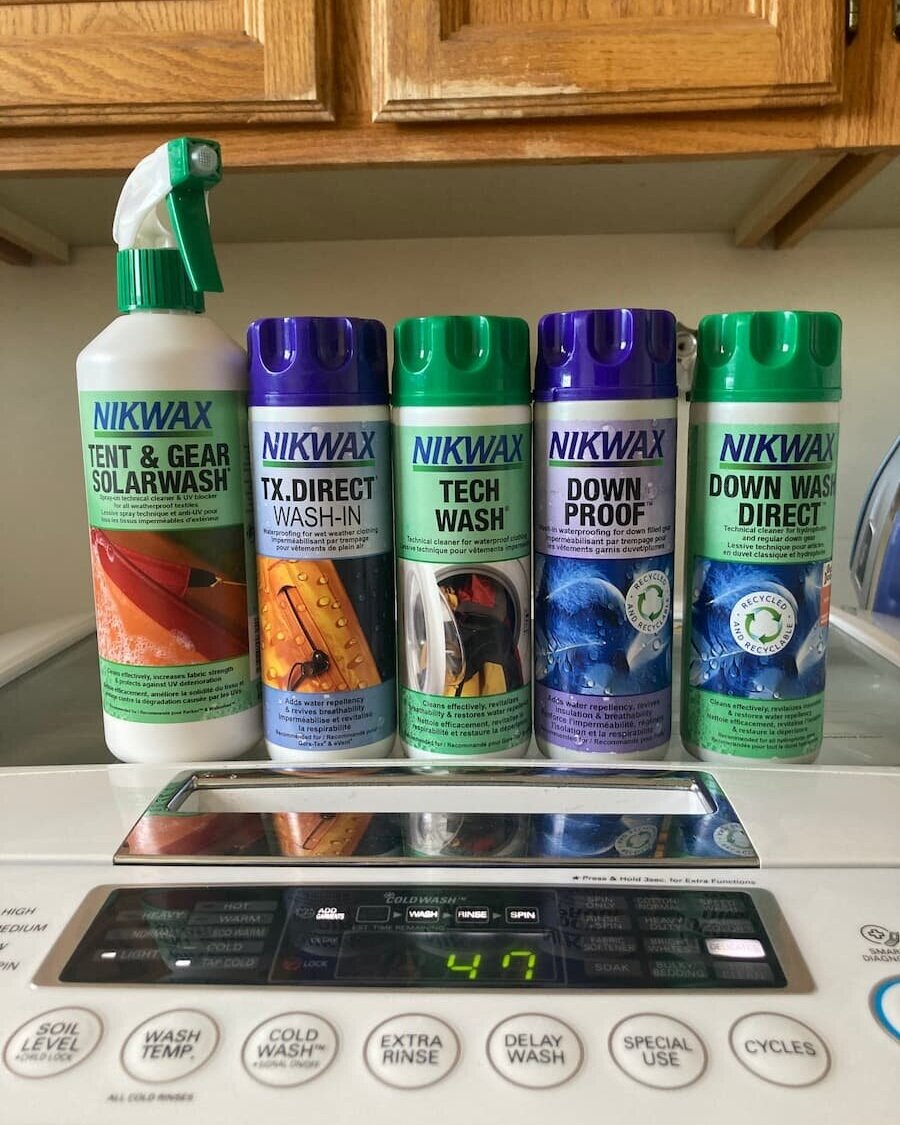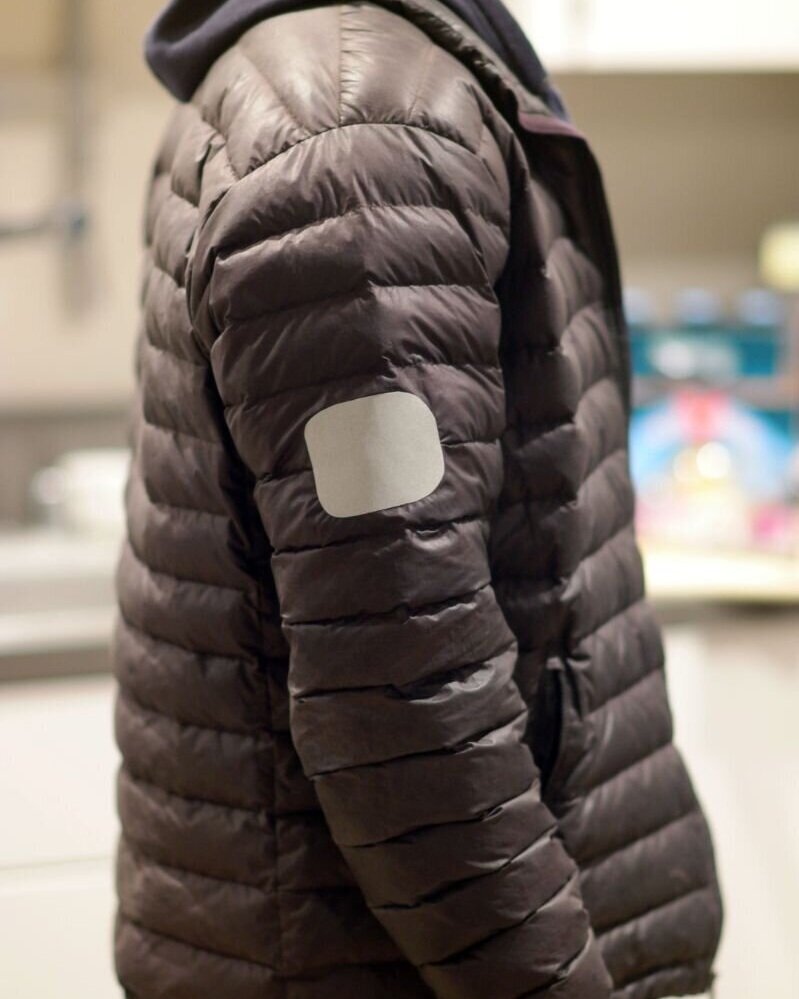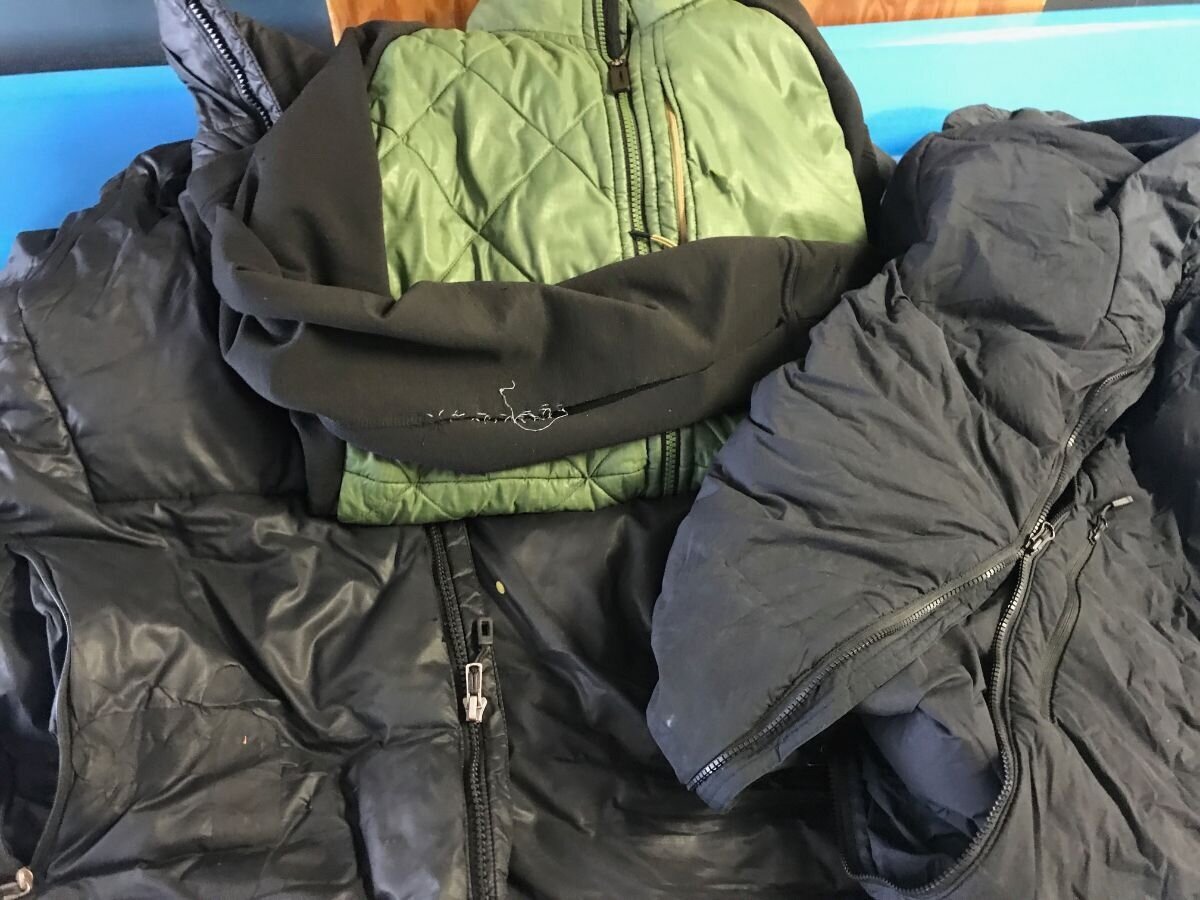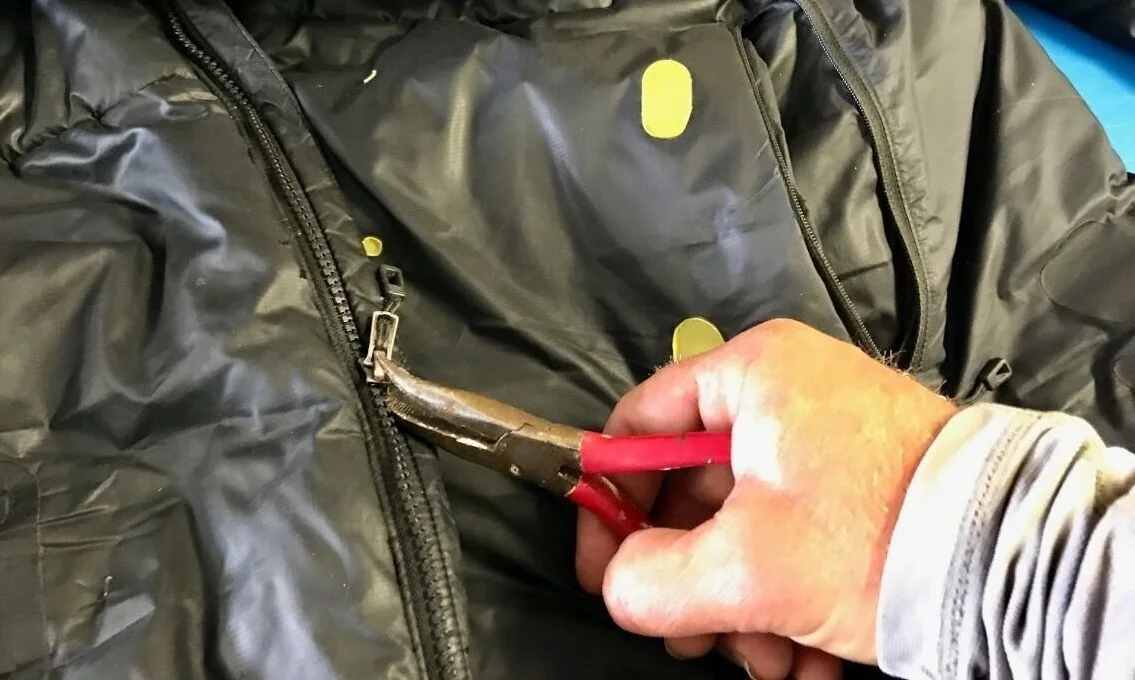How to Clean and Repair Down Jackets
Getting the Most out of Your Down Jacket Investment
Cleaning down jackets can remove campfire odors and ensure the long life of a favorite piece of gear. Photo by Duncan Cheung.
Updated December 8th, 2024
An ultra-lofty down jacket is the luxury item of the outdoors. It’ll keep you cozy without costing too many ounces in your pack, and even doubles as a pillow. An item this essential and well-loved should be cared for so it’ll last for as many adventures as possible. Here are some tips on how to clean and care for your favorite down puffy.
Related: Best Down Jackets and Best Synthetic Jackets
Read More: How to Wash a Down Sleeping Bag
A quick patch job can prevent any more down from escaping from holes, snags, and tears on a down jacket. Photo by Brandon Lampley.
Part 1: Anatomy of down jackets
Down jackets are typically constructed with a lightweight shell (often nylon ripstop for the exterior and taffeta inside) that is stitched into compartments known as baffles, and stuffed with down fill. The compartments help keep the down from bunching up, so it stays lofty and keeps you warm. You'll find similar construction on a down sleeping bag, which also uses baffles to keep down in place and prevent it from bunching.
Down puffies are usually constructed with lightweight synthetic fabrics in order to keep the jacket light and packable. When down gets dirty or compressed repeatedly, it loses some of its loft and therefore, some of its warmth.
Losing downy feathers through holes in the shell can also decrease warmth. So, keeping your down jacket clean and patched when necessary will help extend the life and maintain the warmth of your puffy.
Cleaning down garments is a way to ensure their long life. Photo by Stasia Stockwell
Part 2: How to clean down jackets
We do not recommend dry-cleaning down products as the chemicals can strip oils from the down. Below we outline how to wash down yourselves, but if you don't have the time, several companies offer mail-in services.
This process will clean your technical down jacket but is similar to the process to wash a sleeping bag (sleeping bags take longer to dry and require care in handling a heavier and bulkier piece of gear). Washing a down jacket can be a good way to learn the process before you wash your sleeping bag.
Related: Best Sleeping Bags
Step 1
Before washing, always check tags and care instructions from the maker. While most outdoor down jackets can be washed the same way, some may have specific guidelines.
Step 2
Be sure to use the right washing machine when washing down jackets and other down-filled garments. A front-loading washing machine is ideal, though top-loading machines without an agitator in the center can also work. Most importantly, do not use a washing machine that has an agitator, as that can damage down-filled garments.
Washing a down jacket has many similar steps as washing a down sleeping bag and can be done in a home front loading washing machine. Photo by Liz Thomas
Step 3
Your regular laundry detergent and fabric softener are not ideal for washing outdoor clothing, since the chemicals used in them can damage down and lead to a reduction of its loft. With the right cleaning solution and method, your jacket should regain loft after washing.
We prefer Nikwax Down Wash Direct for both regular and treated hydrophobic down jackets. This biodegradable mild soap is formulated specifically for use with down garments (as compared to garments made of synthetic insulation). It can be placed in the detergent compartment (just be sure that it is free of residue from other soaps). Another brand that is highly recommended is Grangers Down Wash, but it can be more difficult to find in the US.
Step 4
Make sure pockets are empty and all zippers, including the main front zipper, are all zipped up before washing to prevent any bunching or stretching. If you've got a stain on the outer fabric, use a damp cloth to wipe it away. Unlike a regular laundry load, you’ll only want to wash 1-3 down garments per load.
Related: How to Fix a Zipper on Outdoor Gear
Step 5
Follow care instructions for the cleaning solution you’re using. You’ll likely want to use warm water (not hot). Run the gentle cycle or delicate cycle to avoid ripping baffles. Be sure that the rinse cycle and spin cycle at the end of the wash is also on the gentle cycle to remove excess water without damaging your down garments.
Step 6
After the wash cycle is complete, you’ll want to dry and fluff your jacket. Use a regular tumble dryer on low heat or delicate settings. A clean tennis ball or dryer balls placed with your garment into the dryer can help fluff the jacket. This will help to loosen any clumps in the down and allow the jacket to regain loft. As the interior lining fabric is usually far more breathable than the exterior shell fabric, turning your jacket inside out before drying usually speeds the drying process. Check on your jacket regularly until it is completely dry to the touch. When you think it is dry, set it on a drying rack overnight before storage.
A patch can extend the life of a down jacket. Photo by Jocelyn Crawford.
Part 3: How to repair holes in down jackets
The dreaded snag or burn hole is bound to happen at some point in the life of a down garment. Thankfully, a quick patch job can keep all the feathers snug in the baffles.
Step 1
You’ll need a patch made for outdoor gear, something like Tenacious Tape. You can find pre-cut patches, but if you’re using a roll of repair tape, you’ll need to cut it to the appropriate size to cover the hole. Make sure to leave a little overlap and to round the patch's edges.
In our Eco-friendly Gear Swaps story, we discuss how in a pinch, duct tape can repair outer fabric rips and tears when you’re in the field. When you get home, we recommend replacing duct tape with dedicated gear tape patches before washing.
Step 2
Gently tuck any stray feathers back into the jacket baffle before applying the patch. Clean the area around the hole with a damp cloth to remove any dirt from the shell fabric. This will help the patch adhere better. Unlike shell jackets like ski or rain jackets, you don’t want to wash a down jacket before repairing a hole since the wash and dry cycles will cause a down garment to lose its feathers.
Step 3
Apply the patch, ensuring the face fabric is free of creases, and allow it to cure (ideally for a couple of days if possible) before using again. SeamGrip is nice for gluing down the edges of patches on high wear areas but may be unsightly for some.
Related: Best Lightweight Rain Jackets
How you use your down jackets in the field—including choices on how close to sit to a fire—can impact its longevity and durability. Photo by Duncan Cheung.
Part 4: Tips for keeping your down jacket in good shape
If you’ve splurged on a great outdoor down jacket, it is probably so that you can put it through the wringer on your outdoor adventures. Though they are well-made and designed to endure through the elements, there are some simple things you can do to keep your puffy in good shape and make it last as long as possible.
Wash your down jacket regularly
Washing your puffy a few times each season, or after a particularly dirty adventure, will help the down maintain loft. It will also reactivate the DWR (durable water repellent) coating if there is one on the shell. Also, make sure to patch any holes in the jacket immediately to avoid losing any feathers.
Protect your down in the field
If you’re bushwhacking through dense foliage, toss a shell or other layer over your puffy to prevent tears. These jackets are durable, but they’re also made to be lightweight and packable. Wearing a layer that is more abrasion resistant, like a shell, will stop snags in the thin shell of your puffy.
If you think you’ll be bushwhacking or traveling through rough terrain, we recommend switching our puffy jacket out for a Softshell Jacket or a fleece jacket (if you don’t need the weather resistance). Both are designed to be more durable, have more abrasion-resistance generally, and won’t lose their insulation abilities if they develop a tear.
Protect your down from fire
Embers are well-known for putting holes into puffy jackets. If you’re lounging around the campfire, toss a layer over the puffy that is less susceptible to burn holes, or wear an insulating layer that you don’t mind getting a small hole or two in.
Bringing your damaged gear to repair professionals can extend their life. Photo by Brandon Lampley
Part 5: When you can’t fix it yourself: brands that offer warranties and repairs
Sometimes your outdoor apparel may be beyond self-repair. Or, maybe you’d prefer to leave it to the professionals. Either way, there are several companies that offer cleaning and repairs for their apparel.
Mail-In Services
Patagonia offers repairs on any of its items. Most repairs are free, though some highly technical garments or tricky repairs may incur a small charge. Patagonia asks that you clean your gear before sending it in for repair.
Feathered Friends offers cleaning services and repairs for all Feathered Friends jackets.
Arc’teryx offers repairs as well as cleaning on any of their technical apparel. Items that meet warranty requirements will be repaired for free; those that don’t can be repaired at a reasonable price. Arc’teryx will also clean your garments for an added, reasonable cost.
REI Repairs is partnered with Rainy Pass Repair Inc. for fabric repairs on jackets. As a third party, these services are not free but are a great resource for cleaning and repairing gear that is not warrantied by the maker.
Rab offers a down washing service. They will send you a bag with pre-paid postage, wash your jacket, and send it back to you.
Local Services
Working with a local gear repair business is a good way to extend the life of your outdoor equipment as you are able to show specialists exactly where and what issues need fixing. Six Moon Designs maintains the most extensive list we’ve found of quality local outdoor gear repair shops around the US. It includes repair shops in 17 different states, so you’re likely to find one in your region that can provide the services you need.
Why You Should Trust Us & About the Author
Stasia Stockwell is a lifelong skier who has spent an average of 50 days skiing each season since she could walk. She has taken classes on all-mountain skiing techniques and has her AIARE Level 1 avalanche safety certification. Her work in the industry spans from testing and reviewing skis for Backpacker Magazine to working on ski videos for Atomic skis.
Stasia has written for Backpacker Magazine, REI Co-op Journal, The Dyrt Magazine, and more. You can find more of her writing, gear reviews, and adventures on her her website or all her Treeline Review stories on her author page.


